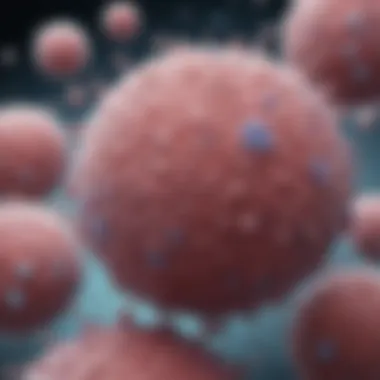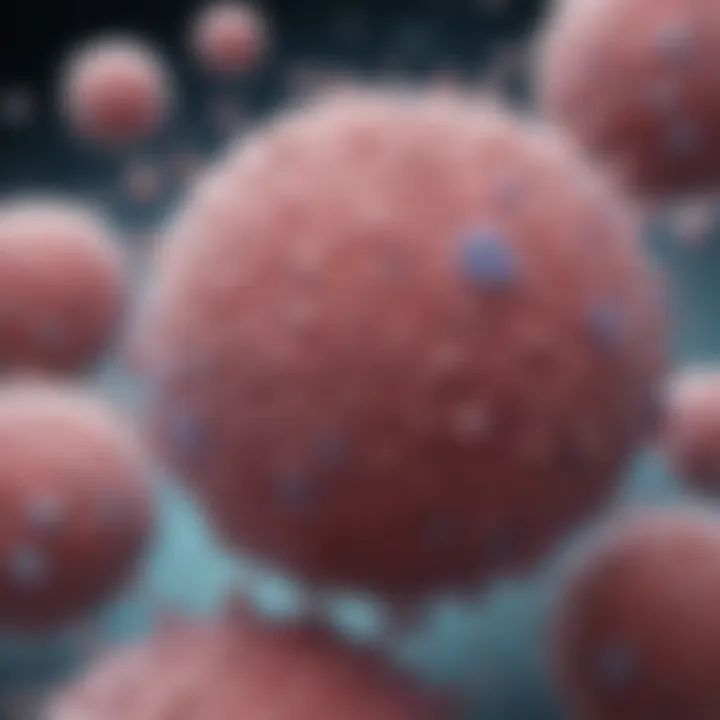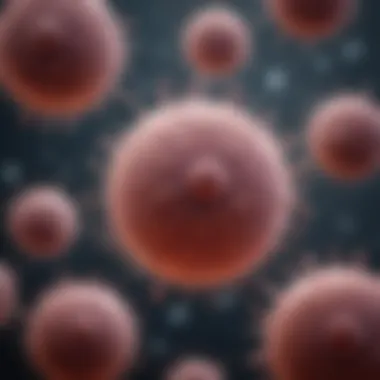In-Depth Analysis of HEK293F Cells and Their Applications


Intro
HEK293F cells stand as a vital component in the landscape of cell biology and biotechnology. These cells, derivatives of human embryonic kidney 293 cells, are extensively utilized in various applications ranging from recombinant protein production to vaccine development. Given their unique characteristics, HEK293F cells offer scientists a robust tool for research and development.
This article provides a comprehensive examination of HEK293F cells, analyzing their origins, biological traits, and significance across different fields. The discussion navigates through the cellular properties, genetic engineering methodologies, and the pivotal role these cells play in creating therapeutic proteins. Moreover, it highlights advancements in cell culture practices and future trends poised to shape research and industry applications. Understanding these facets can enhance insights into their relevance in current biotechnological innovations.
By delving into the attributes and transformative uses of HEK293F cells, this work targets an audience comprising students, researchers, educators, and professionals.
Purpose of the Article
The primary aim of this article is to present an in-depth analysis of HEK293F cells, elucidating their relevance in biotechnology. By shedding light on their characteristics and numerous applications, the article seeks to inform the audience about their significance in modern science and broaden the knowledge base in cell biology.
Relevance to Multiple Disciplines
HEK293F cells are not confined to a single discipline. Their applications extend to molecular biology, pharmacology, and vaccine production among others. This cell line serves as an essential model for scientific research, providing insights that transcend traditional boundaries. Understanding the functionality and versatility of HEK293F cells can enhance collaboration and foster innovation across various scientific domains.
Prelude to HEK293F Cells
HEK293F cells represent a pivotal element in the field of biotechnology due to their unique properties and versatile applications. Understanding these cells is essential for researchers and professionals involved in various areas of biological research and therapeutic developments.
These cells derive from human embryonic kidney cells, which have been modified to improve growth and productivity in laboratory settings. HEK293F cells are particularly important for the production of recombinant proteins and are widely used in vaccine production. Their ease of culture and high transfection efficiency promote their utility in gene therapy and other genetic engineering applications.
Moreover, the exploration of HEK293F cells goes beyond their basic biological characteristics, as researchers increasingly focus on optimizing culture conditions and developing innovative genetic modifications. This article discusses the numerous factors that make HEK293F cells a topic of great significance in modern biotechnology.
Historical Background
HEK293F cells were originally derived from human embryonic kidney cells in the early 1970s. The cell line was transformed with sheared adenovirus DNA, which contributed to their rapid growth and ability to thrive in suspension culture. This transformation was crucial, enabling the cells to exhibit characteristics desirable for biopharmaceutical applications, such as high transfection rates and reliable protein production. Over the decades, researchers have refined the use of HEK293F cells, leading to their widespread adoption in various biomedical sectors.
Definition and Classification
HEK293F cells belong to a family of cell lines broadly classified as adherent and suspension cells. The extraction and adaptation of HEK293 cells into the HEK293F variant allowed for a more efficient culture system, enabling the cells to grow in a suspension format without the need for solid surfaces.
This classification allows for adaptability in various experimental and production settings. All these factors underscore the practicality of HEK293F cells for both academic and commercial research environments. Their designation as a human cell line also affords a level of relevance in studies aimed at human therapeutics, making them a focus of ongoing research efforts.
Biological Characteristics of HEK293F Cells
Understanding the biological characteristics of HEK293F cells is crucial for their effective application in biotechnology and research. These cells not only serve as a model for studying various cellular processes, but they also play a significant role in the production of recombinant proteins, vaccines, and other biopharmaceuticals. Their unique properties allow scientists to manipulate and utilize them in various experimental setups, thereby enhancing productivity and yield in biomanufacturing.
Cell Lineage and Origin
HEK293F cells are derived from the human embryonic kidney 293 cell line, specifically modified to enhance their growth properties. The initial HEK293 cell line was created in the late 1970s, using embryonic kidney cells from a terminated pregnancy. The ‘F’ in HEK293F refers to the fine-tuning of these cells for suspension growth in serum-free media. This modification leads to increased cell density and faster growth rates compared to their adherent counterparts. Additionally, HEK293F cells have been shown to be highly amenable to genetic manipulation, making them a favorable platform for gene expression studies and protein production.
Morphology and Growth Properties
HEK293F cells exhibit characteristic rounded morphology, which allows for easy suspension culture. The cells can grow rapidly, achieving confluency in just a few days under optimal conditions. Their doubling time is notably shorter than many other mammalian cell lines, often around 24 hours. This rapid proliferation makes them highly desirable for biopharmaceutical production. Furthermore, HEK293F cells are robust, demonstrating resilience to various growth factors and conditions.
Some additional important growth properties include:
- Adaptability to various media types, including serum-free formulations.
- High transfection efficiency, allowing for effective introduction of DNA into the cells, which is invaluable for producing recombinant proteins.
- Ability to grow in high-density suspension, suitable for large-scale bioprocessing and production.
"The unique biological characteristics of HEK293F cells provide a distinct advantage in the field of biotechnology, especially in the context of rapid, high-yield protein production."
"The unique biological characteristics of HEK293F cells provide a distinct advantage in the field of biotechnology, especially in the context of rapid, high-yield protein production."
In summary, the biological characteristics of HEK293F cells highlight their potential and versatility in biotechnological applications. Their lineage, rapid morphology, and exceptional growth properties distinguish them from other cell lines, reinforcing their importance in modern research and industry.
Genetic Engineering and Modifications
Genetic engineering and modifications are critical aspects of working with HEK293F cells. These techniques enable researchers to manipulate the cells' genetic material, resulting in customized cellular behavior tailored for specific applications in biotechnology. The ability to introduce or modify genes provides significant benefits, which include the enhanced production of proteins or other bioproducts. Moreover, these cells serve as versatile platforms for studying gene function, protein interactions, and pathways involved in different biological processes.
This section delves into the specific techniques employed for gene manipulation, highlighting their benefits and considerations for researchers aiming to maximize the effectiveness and efficiency of their studies.
Transfection Techniques
Transfection is the method used to introduce foreign DNA or RNA into HEK293F cells. Various techniques exist, each with its own set of advantages and potential challenges. Common transfection techniques include lipid-mediated transfection, electroporation, and viral delivery systems.
- Lipid-mediated transfection uses liposomes to facilitate the entry of nucleic acids into cells. This method is often favored due to its simplicity and effectiveness in a variety of settings.
- Electroporation involves applying an electrical field to create temporary pores in the cell membrane, allowing DNA or RNA to enter. This technique generally enhances the efficiency of transfection but can be harsh on cells, impacting their viability.
- Viral delivery systems, such as retroviral or lentiviral vectors, leverage the natural ability of viruses to infect cells. This method can ensure stable integration of the genetic material, which is beneficial for long-term studies.
Choosing the appropriate transfection technique often relies on factors such as the specific application, the desired expression level, and the possible impact on cell health.
Stable vs. Transient Expression Systems
In genetic engineering, researchers utilize stable or transient expression systems depending on their experimental goals.
Stable expression involves integrating the desired gene into the genome of the HEK293F cells. This method produces a continuous supply of the target protein and is ideal for long-term studies or biopharmaceutical production. The establishment of stable cell lines, however, can be time-consuming and may require multiple selection steps to isolate cells that maintain the desired traits.


In contrast, transient expression allows for the rapid production of proteins without the need for genomic integration. Researchers can achieve high yields within a short timeframe, making this option advantageous for experiments requiring quick results or for screening purposes. However, protein production in transient systems is typically less consistent and may require repeated transfections for prolonged studies.
Understanding the differences between these two systems is essential for optimizing the specific requirements of various applications. Each system has its role, and the choice must align with the overall objectives of the research.
Applications in Biopharmaceuticals
The utilization of HEK293F cells in biopharmaceuticals is foundational in the advancement of modern medicine. These cells are employed primarily due to their capacity for high yields of therapeutic proteins and their suitability for various biotechnological applications.
Production of Therapeutic Proteins
HEK293F cells are pivotal in the production of therapeutic proteins, which include antibodies, hormones, and enzymes vital for treating a myriad of diseases. The advantages of using HEK293F cells for this purpose are numerous:
- High yield: These cells tend to produce substantial amounts of proteins in a relatively short time frame. This efficiency is critical, especially in the face of global health challenges that require rapid responses.
- Post-translational modifications: HepG2 cells can perform the necessary modifications such as glycosylation, which are essential for the functionality of many therapeutic proteins. This biological similarity to human cells enhances the effectiveness of the resulting therapeutics.
- Scalability: The ability to scale the cultures of HEK293F cells for large-scale production makes them preferable in the industry. This feature supports the increasing demand for biopharmaceuticals in the market today.
In practice, HEK293F cells are transformed with plasmids that encode the gene of interest. Following transfection and selection, producers can harvest the proteins of interest after a few days of growth. This practical approach allows for faster and more efficient therapeutic protein production.
Role in Vaccine Development
HEK293F cells also play an important role in vaccine development. Their unique properties support the production and testing of various types of vaccines, including those for viral infections. The relevance of these cells in vaccine research can be outlined as follows:
- Platform for viral vectors: HEK293F cells serve as a crucial platform for generating viral vectors used in live-attenuated vaccines. They can facilitate the replication of certain viruses, enabling researchers to develop effective vaccines.
- Safety and efficacy testing: The use of HEK293F cells in vaccine testing is significant for establishing safety and efficacy profiles before proceeding to clinical trials. This can enhance public trust in vaccines, an essential factor in healthcare.
- Expression systems: In recombinant vaccine strategies, HEK293F cells can produce antigenic proteins that stimulate immune responses. Their ability to correctly fold and modify these proteins means they can be used directly in vaccine formulations.
The extensive use of HEK293F cells in the field of biopharmaceuticals signifies their irreplaceable role in modern medicine, combining efficiency with safety to meet healthcare demands.
The extensive use of HEK293F cells in the field of biopharmaceuticals signifies their irreplaceable role in modern medicine, combining efficiency with safety to meet healthcare demands.
Cell Culture Techniques
Cell culture techniques are pivotal in the research and application of HEK293F cells. These methods directly impact the quality, yield, and functionality of the biological products derived from cell cultures. It is essential to master cell culture techniques, as they allow researchers to maintain and manipulate these cells for effective use in various biotechnological applications.
Media Composition and Optimization
The growth and functionality of HEK293F cells are significantly influenced by the composition of the culture media. Media needs to provide the right nutrients, growth factors, and pH levels. Commonly used media include Dulbecco's Modified Eagle Medium (DMEM) or FreeStyle 293 Expression System, which cater specifically to HEK293F cells.
A well-balanced media not only supports cell growth but also enhances protein expression levels. Adjusting the components like amino acids, vitamins, and serum can optimize conditions tailored to specific applications. For instance, the addition of specific additives can increase transfection efficiency or protein yield.
It is crucial to conduct systematic optimization studies to determine the ideal media formulation for specific experimental needs. Common practices for optimization include:
- Testing different serum concentrations to find the minimum that supports growth while reducing costs.
- Incorporating growth factors that can promote cell viability and productivity.
- Assessing different pH levels and salt concentrations to optimize metabolic activity.
Scale-Up Strategies for Industrial Applications
As HEK293F cells are favored in biopharmaceuticals, scaling up production is essential for industrial applications. The transition from laboratory-scale cultures to larger bioreactors presents unique challenges.
Various strategies can be employed for effective scale-up:
- Batch Culture Systems: This is the simplest way to maintain culture conditions for larger volumes. However, nutrient depletion and metabolism byproducts can limit cell growth.
- Fed-Batch Cultures: Here, nutrients are added continuously or in discrete batches to prolong cell growth phases and improve yields.
- Continuous Cultures: These systems maintain cells in a state of exponential growth. In such systems, fresh media replaces spent media constantly, allowing for higher density and protein production.
Each of these strategies has merits depending on the goal of the production, but they all require careful monitoring of parameters such as temperature, pH, and dissolved oxygen levels. Codifying best practices through real-time data collection can help identify successful approaches, ultimately influencing productivity and scale-up efficiency.
In summary, mastering cell culture techniques, specifically media optimization and scaling strategies, is vital for harnessing the full potential of HEK293F cells in biotechnology. The ongoing advancements in these areas will strengthen their applications in therapeutic development and other biopharmaceutical endeavors.
Current Research Trends
Understanding the current research trends regarding HEK293F cells is essential for leveraging their full potential in biotechnological applications. Recent advancements highlight not only the innovative methodologies being employed in research but also the implications these trends have on the future of vaccine development, protein production, and gene therapy. Focused advancements in gene editing and cell engineering are set to invigorate research, opening new avenues for exploration and application.
Innovations in Gene Editing
There have been significant breakthroughs in gene editing technologies that utilize HEK293F cells as a platform. The CRISPR-Cas9 system, for example, has become a cornerstone in modern genetics. The ability to make precise alterations to the genome has revolutionized how researchers approach genetic modifications.
When applied to HEK293F cells, CRISPR-Cas9 allows for tailored modifications that enhance the cell's utility in producing therapeutic proteins. These tailored cells can exhibit improved expression rates for specific proteins, thereby increasing the efficiency of biopharmaceutical production. Moreover, these cells can be engineered to knock out unwanted genes, providing a clean slate for studying gene function.
Another innovative technique is the application of base editing, which improves specificity while reducing off-target effects. This method can address mutations with high precision, a significant advantage when developing cellular models for studying diseases or for therapeutic purposes.
"Innovations in gene editing are not just enhancing HEK293F's capabilities; they are reshaping our entire understanding of cellular biology."
"Innovations in gene editing are not just enhancing HEK293F's capabilities; they are reshaping our entire understanding of cellular biology."
These advancements hold promise for developing personalized medicines, where gene editing can create patient-specific cell lines that better mimic individual responses to treatments. The versatility of HEK293F cells in gene editing significantly elevates their status within research communities.
Advancements in Cell Engineering
The field of cell engineering has witnessed remarkable progress, particularly in optimizing HEK293F as a cell line suitable for high-yield protein expression. Recent advancements involve the use of synthetic biology techniques which streamline the design and optimization of expression vectors. Methods like plasmid assembly using Gibson assembly or Golden Gate cloning have drastically improved the speed and efficiency of generating expression clones.
In addition, researchers are making strides in customizing cell culture systems. For example, bioreactor technology allows for the precise control of environmental conditions, which translates to higher cell viability and productivity. This is particularly beneficial for large-scale production of vaccines and biopharmaceuticals, as HEK293F cells can adapt well to suspension culture methods.
Another noteworthy advancement is the development of adaptive cell culture media. These formulations maximize growth and productivity by supplying essential nutrients while minimizing stress factors. The right media composition can enhance protein yield significantly, thereby ensuring economic viability for industrial applications.


Furthermore, encapsulating HEK293F cells in 3D culture systems has opened new pathways for research. These systems create a more native-like environment, improving cellular behavior and protein production. They allow for better mimicking of in vivo conditions, which is crucial in drug development and toxicity assessments.
The ongoing enhancements in cell engineering are not just increasing the popularity of HEK293F cells; they are defining its role as a primary choice for researchers in academia and industry alike. The continual adoption of innovative techniques in gene editing and cell engineering underscores the bright future of HEK293F in biotechnology and pharmaceutical development.
Ethical Considerations
The ethical considerations surrounding HEK293F cells are fundamental in guiding research practices and ensuring compliance with regulatory requirements. The utilization of these cells in various applications necessitates a robust understanding of the ethical implications. Researchers must navigate a complex landscape that includes informed consent, tissue sourcing, and animal welfare. These elements are critical, as they lay the groundwork for responsible use and maintain public trust in scientific endeavors.
Regulatory Frameworks
Regulatory frameworks play a vital role in shaping how HEK293F cells are employed in research and industry. Agencies like the U.S. Food and Drug Administration (FDA) and the European Medicines Agency (EMA) have established guidelines to ensure that cell line usage aligns with ethical standards. They govern key areas such as the validation of cell lines, quality control, and safety assessments. These regulations aim to mitigate risks associated with potential contamination or genetic instability, ultimately protecting consumer health and safety. Researchers must remain vigilant and informed about these regulatory requirements, as adherence is paramount in any biopharmaceutical or research application involving HEK293F cells.
Impact on Research Practices
The ethical considerations not only inform regulatory frameworks but also directly impact research practices. The integration of ethical standards leads to enhanced transparency and accountability in studies utilizing HEK293F cells. By fostering an ethical research environment, scientists are encouraged to pursue methodologies that respect the integrity of their work and the sources contributing to it.
"The ethical application of HEK293F cells is not merely a regulatory obligation but a moral responsibility that upholds scientific integrity."
"The ethical application of HEK293F cells is not merely a regulatory obligation but a moral responsibility that upholds scientific integrity."
Moreover, ethical concerns often prompt institutions to establish review boards that scrutinize research proposals involving human-derived materials. This review process is essential in ensuring the welfare of donors and subjects involved in research. Ultimately, addressing ethical considerations in HEK293F research contributes to a culture of innovation that respects human rights while advancing scientific knowledge.
Future Directions in HEK293F Research
The exploration of HEK293F cells is continually evolving. As researchers push boundaries, examining future directions for this cell line enhances understanding and reveals untapped potential. As a model system, HEK293F cells have vast implications for various biotechnological and medical advancements.
Emerging Technologies
Recent innovations in biotechnology play a pivotal role in shaping the future of HEK293F research. One key area is the integration of advanced gene editing techniques, such as CRISPR/Cas9. This technology allows precise modifications of the HEK293F genome, enabling researchers to study gene functions and develop customized cell lines for specific research objectives.
Furthermore, automation in cell culture processes is set to revolutionize how HEK293F cells are utilized. Implementing robotics and AI-driven systems enhances efficiency and scalability in laboratory settings. High-throughput screening methods can also expedite the development of new formulations and evaluate the effectiveness of various therapeutic proteins produced in HEK293F cells.
Additionally, bioinformatics tools are becoming increasingly essential. They allow researchers to analyze vast datasets efficiently, enhancing the understanding of cell behavior in different environments. This combination of technology not only accelerates research but also improves the quality and reproducibility of experimental results.
Potential for Novel Applications
The versatility of HEK293F cells opens doors to novel research applications. One notable area of exploration is their utilization in synthetic biology. By engineering HEK293F cells to produce novel compounds or synthetic proteins, researchers can address specific needs in pharmaceuticals and agriculture.
Another potential application lies in personalized medicine. HEK293F cells could serve as a platform to produce patient-specific therapeutic proteins tailored to individual genetic profiles. This could significantly enhance the efficacy of treatments, ensuring better patient outcomes.
Moreover, the role of HEK293F in vaccine production is likely to expand. With the advancement of mRNA technology, HEK293F cells can yield high levels of mRNA vaccines, playing a critical role during public health crises. This flexibility in application makes HEK293F not just a cell line but a fundamental tool in modern science.
In summary, the landscape of HEK293F research is dynamic and poised for significant growth as emerging technologies and novel applications continue to shape its trajectory.
In summary, the landscape of HEK293F research is dynamic and poised for significant growth as emerging technologies and novel applications continue to shape its trajectory.
By recognizing these future directions, researchers can maximize the potential of HEK293F cells, paving the way for breakthroughs within the biotechnology industry.
Case Studies: Successful Applications of HEK293F Cells
HEK293F cells have risen to prominence in biotechnology, particularly due to their versatility and efficacy in various applications. This section will explore two notable examples: monoclonal antibodies production and gene therapy development. Each case study underscores the significance of HEK293F cells in real-world biopharmaceutical processes.
Monoclonal Antibodies Production
Monoclonal antibodies (mAbs) represent a cornerstone of therapeutic treatment in numerous diseases. HEK293F cells are especially advantageous in producing these antibodies. Their ability to grow quickly and produce high yields of glycosylated proteins makes them ideal for this purpose. Moreover, these cells are capable of complex post-translational modifications that enhance antibody efficacy and stability.
Production often involves transfecting HEK293F cells with plasmids containing the genes responsible for the desired antibody. Once transfected, these cells can be cultured in suspension, allowing easy scalability for large-scale production. This cultivation method further simplifies the purification process. In 2018, a significant milestone was reported when a specific mAb produced from HEK293F cells gained regulatory approval. This marked a key turning point, showcasing the reliability of HEK293F cells in meeting industry standards.
"The use of HEK293F for mAbs production exemplifies the blend of efficiency and precision required in modern biopharmaceutical production."
"The use of HEK293F for mAbs production exemplifies the blend of efficiency and precision required in modern biopharmaceutical production."
Gene Therapy Development
Gene therapy has emerged as a revolutionary approach to treating genetic disorders and other ailments. HEK293F cells facilitate the production of viral vectors that carry therapeutic genes to target cells. The adaptability and transformability of HEK293F cells allow for efficient vector generation.
Researchers have successfully utilized these cells to create adenoviral vectors, which are vital in delivering genetic material to cells. The straightforward transfection protocols employed add to their appeal, providing a streamlined path for researchers. Notable advancements in clinical trials for gene therapy have employed products derived from HEK293F, offering hope for conditions that previously had limited treatment options.
Challenges in HEK293F Research
Research involving HEK293F cells presents multiple challenges that researchers must navigate. Understanding these hurdles is crucial for leveraging the capabilities of this cell line effectively. While HEK293F cells are valuable in biopharmaceutical production and genetic research, they also come with limitations that can impact experimental outcomes and scalability. Thus, addressing these challenges is paramount in advancing research and optimizing the use of HEK293F cells in various applications.
Limitations of Current Methods
The methodologies employed in HEK293F research can pose significant barriers. One major limitation is related to transfection efficiency. Although HEK293F cells are known for their high transfection rates, variability exists across different laboratories. Factors such as reagents used, protocol variations, and even cell passage number can influence results. This inconsistency can create difficulties in reproducing experiments or obtaining reliable data. Additionally, the transient expression systems often utilized may not sustain long-term expression of proteins, making them less suited for certain applications.
Moreover, the reliance on serum-containing media can complicate the scalability of processes aimed at protein production. The variability in serum composition can lead to inconsistent growth rates and productivity, which are essential parameters in industrial settings. Researchers must also consider the impact of heterogeneity present in cell populations. Even minor differences in cell characteristics can lead to considerable variations in experimental outcomes.


Addressing Contamination Issues
Contamination is another critical concern in HEK293F research. The risk factors for contamination arise from various sources, including bacterial, fungal, and mycoplasma infections. Such incidents can compromise experimental integrity and lead to bias in results. To mitigate these risks, strict aseptic techniques must be practiced rigorously. This includes regular monitoring of cell cultures for signs of contamination and the implementation of robust sterilization practices.
Regular testing for mycoplasma contamination is necessary, as it can have devastating effects on cell function and alter experimental results.
Regular testing for mycoplasma contamination is necessary, as it can have devastating effects on cell function and alter experimental results.
Additionally, adopting closed-system culturing methods can help reduce the exposure of cell cultures to environmental contaminants. Utilizing stringent quality controls and investing in better containment policies can enhance the safety and reliability of HEK293F research. Furthermore, the use of antibiotic-containing media is debated among researchers due to the potential for resistance development. Therefore, the best approach often involves a combination of good laboratory practice and enhanced monitoring techniques to maintain culture purity.
Comparison with Other Cell Lines
In the realm of biopharmaceutical research and development, understanding the distinctions between various cell lines is essential. Cell lines serve as fundamental tools for studying cellular behavior, drug discovery, and producing biopharmaceuticals. HEK293F cells are often compared with other popular cell lines, notably Chinese Hamster Ovary (CHO) cells, each presenting unique properties that may favor specific applications. This comparison highlights critical aspects such as growth characteristics, post-translational modifications, and overall yield in producing proteins.
HEK293 vs. CHO Cells
HEK293F cells and CHO cells are widely used in research and industry. HEK293F originates from human embryonic kidney cells and offers a fast growth rate, which is advantageous for transient expression systems. In contrast, CHO cells, derived from ovarian cells of Chinese hamsters, are well-established for stable long-term protein production. Here are key points on both:
- Transfection Efficiency: HEK293F shows high transfection efficiency, making it suitable for rapid protein production, up to ten times greater than CHO.
- Post-Translational Modifications: CHO cells are often preferred when specific glycosylation patterns are needed, as they closely mimic human glycosylation and are less likely to trigger an immune response.
- Culture Conditions: HEK293F cells thrive well in suspension culture, providing versatile options for scale-up, while CHO cells may require more stringent culture conditions.
- Regulatory Status: CHO cells have a longer history of regulatory acceptance for therapeutic products, leading to more extensive compliance documentation.
- Application Suitability: For antibody production or complex proteins requiring human-like modifications, CHO might be the go-to choice, whereas HEK293F is suitable for less complex proteins or rapid prototyping.
Unique Features of HEK293F
HEK293F cells exhibit unique features that set them apart from other cell lines. Their human origin ensures relevant biological responses when appropriate applications are conducted. Here are some distinctive traits of HEK293F:
- Rapid Growth: These cells can double in number every 24-36 hours. This fast replication is ideal for producing proteins in a short time frame.
- Ease of Use: They can adapt to various culture formats, including suspension or adherent cultures, enhancing flexibility in laboratory settings.
- High Yield: HEK293F cells can reach high densities, resulting in increased protein yields.
- Robustness in Transfection: The cell line’s high transfection efficiency significantly shortens the experimentation time, making it attractive for researchers aiming to develop and test multiple constructs quickly.
- Versatility in Applications: Besides protein production, HEK293F cells are employed in studying gene function, signaling pathways, and drug responses due to their human cellular context.
"The choice of cell line can significantly affect the outcome of experiments and biopharmaceutical production, emphasizing the importance of understanding each line's specific strengths and weaknesses."
"The choice of cell line can significantly affect the outcome of experiments and biopharmaceutical production, emphasizing the importance of understanding each line's specific strengths and weaknesses."
Thus, while HEK293F cells present many advantages, it is crucial to consider the desired application when selecting a cell line. Each cell system brings distinct strengths that may suit different research needs and therapeutic projects.
Impact on the Biotechnology Industry
HEK293F cells have significantly affected the biotechnology industry, shaping various processes related to the production and development of biological products. These cells offer unique advantages that make them ideal for applications in both research and commercial settings. In this section, we will delve into the market trends, demands, and overall contribution of HEK293F cells to scientific innovation.
Market Trends and Demands
The demand for HEK293F cells is on the rise due to several trends in the biotechnology industry. The growth in biopharmaceuticals is one key element. Companies increasingly focus on developing targeted therapies, such as monoclonal antibodies and gene therapies, which require efficient expression systems. HEK293F cells provide a robust platform that meets these needs due to their high transfection efficiency and ability to produce complex proteins.
Additionally, the proliferation of personalized medicine is driving the need for customized cell lines. HEK293F cells can be modified to express specific proteins, making them valuable for tailored therapeutic applications. This flexibility supports the ongoing research and development required in this area, thus pushing the market further.
- Rapid Product Development: HEK293F cells can accelerate timelines for product testing and validation.
- Cost Efficiency: Their use can significantly lower production costs compared to other cell lines by optimizing growth and protein yield.
The combination of these factors results in increasing investments in technologies surrounding HEK293F cells as companies strive to stay competitive in the evolving landscape of biotech.
Contribution to Scientific Innovation
HEK293F cells have been crucial in driving scientific innovation across numerous fields. Their origin from human embryonic kidney cells allows them to mimic human cellular processes closely, providing insights that are critical for biomedical research. Through genetic modifications, researchers can create disease models and study gene function in a controlled environment.
One of the major contributions of HEK293F cells is in the field of vaccine development. Their ability to produce specific proteins enables rapid development of antigens needed for vaccine trials. For instance, in recent years, they have been pivotal in the research and production of viral vectors for vaccines against emerging diseases.
Furthermore, HEK293F cells contribute to advancements in gene therapy. They can produce large quantities of viral vectors, crucial in delivering therapeutic genes to patients. This capability is vital for treating genetic disorders, reinforcing the relevance of HEK293F cells in modern medical research.
"HEK293F cells not only enhance the efficiency of developing new therapies but also provide a platform for ground-breaking discoveries in genetics and immunology."
"HEK293F cells not only enhance the efficiency of developing new therapies but also provide a platform for ground-breaking discoveries in genetics and immunology."
In summary, the impact of HEK293F cells on the biotechnology industry is multifaceted. Growing market trends highlight the increasing reliance on these cells, while their significant contributions to scientific innovation illustrate their value in advancing medical and therapeutic strategies.
End
The conclusion serves as a critical synthesis of the entire discussion surrounding HEK293F cells. It wraps up the significance of these cells in modern biotechnological applications, highlighting their advantages and the implications of ongoing research. HEK293F cells have become a staple in various fields, particularly in the development of therapeutic proteins and vaccines. For researchers and practitioners alike, understanding these cells is essential for navigating the complexities within biotechnology.
Summation of Key Insights
In evaluating HEK293F cells, several key insights emerge:
- Versatility in Applications: HEK293F cells have established themselves as valuable tools in research, particularly in drug and vaccine development.
- Robust Growth Properties: Their ability to thrive in suspension culture enhances scalability, making them suitable for industrial processes.
- Genetic Engineering Capabilities: The adaptability of these cells to various transfection techniques allows for efficient production of complex proteins, which is crucial in therapeutic contexts.
- Ethical and Regulatory Compliance: The use of HEK293F cells operates within a framework that encourages transparency and ethical considerations in research.
"HEK293F cells not only contribute to scientific innovation but also offer a framework for future biotechnology developments and innovations."
"HEK293F cells not only contribute to scientific innovation but also offer a framework for future biotechnology developments and innovations."
These insights encapsulate the multifaceted nature of HEK293F cells and their ongoing impact on the biotechnology sector.
Future Prospects
Looking ahead, the future of HEK293F cells appears promising. Several trends and areas of exploration will likely shape their evolution in research and application:
- Advancements in Gene Editing: As CRISPR and other gene-editing technologies evolve, HEK293F cells will play a crucial role in genetic research and protein engineering.
- Integration with Emerging Technologies: The fusion of HEK293F cells with artificial intelligence and bioinformatics could streamline the design of biologics, increasing efficiency and specificity in drug development.
- Focus on Personalized Medicine: With the growing shift towards precision medicine, HEK293F cells could be pivotal in customizing therapies to meet individual patient needs.
- Global Health Initiatives: Their role in vaccine development places them at the forefront of global health efforts, responding effectively to emerging diseases and public health challenges.
These prospects indicate that HEK293F cells will continue to be integral to advancements in biotechnology, allowing for innovative solutions to complex health issues. As the scientific community enhances its understanding of these cells, their utility and application will thrive, contributing significantly to the future of medicine and biotechnology.



